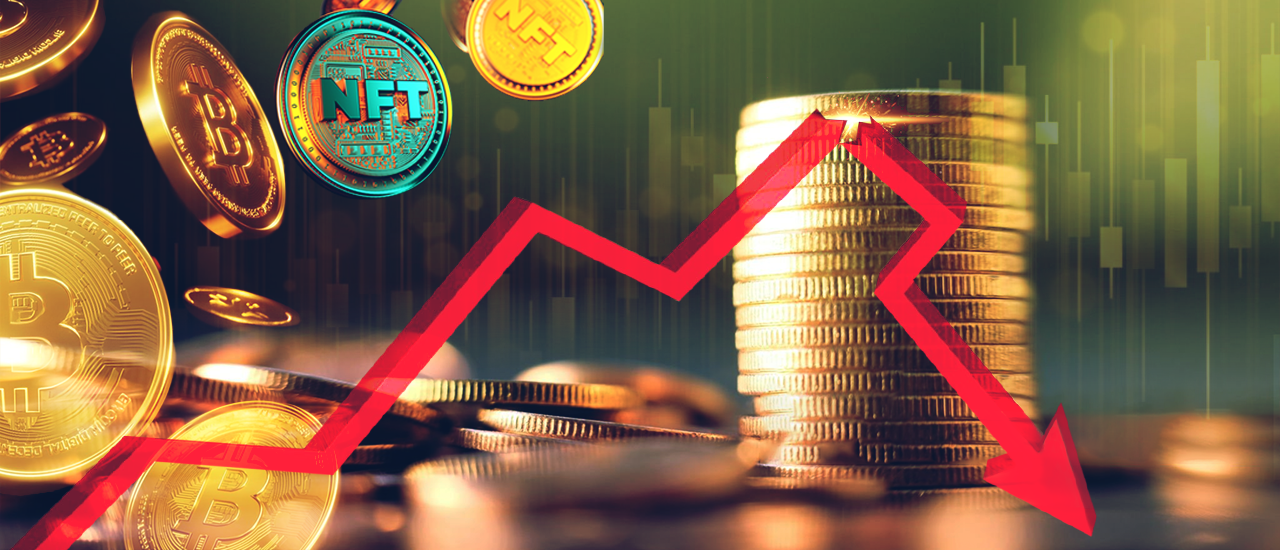Table of Contents
On November 11, 2022, the second biggest cryptocurrency exchange, FTX declared Chapter 11 bankruptcy along with 100+ affiliated entities. This event has dealt a massive blow to the already declining world of crypto.
Since the declaration of FTX’s bankruptcy, some questions have been raised in the crypto world and beyond, such as,
- How can a $32 billion company collapse in a matter of hours?
- What happens to their 1 million+ clients and investors?
- What effect can it have on the world of cryptocurrency?
- And why are these cryptocurrency exchanges collapsing one after another?
In this article, we’ll talk about FTX, its in-house exchange token, FTT, the meteoric rise of FTX, and its unexpected downfall. We’ll also discuss the problems with cryptocurrency exchanges, and what we can learn from this event.
What is FTX?
FTX Trading Ltd. is a Bahamas-based cryptocurrency exchange and trading firm. FTX was founded by Sam Bankman Fried and Gary Wang back in 2019 and was the third-largest crypto exchange by volume with over one million users.
FTX is an abbreviation for "Futures Exchange.". FTX was also closely associated with ftx.us, a separate crypto derivatives exchange exclusive to US residents. Overall, FTX was the second-largest crypto exchange before its collapse.
FTX CEO, The Most Generous Billionaire
Sam Bankman Fried, FTX founder and CEO, was one of the major catalysts behind the company's success. He became the face of the company, as well as crypto at large, to some people. His simple public image also earned him titles like "The Most Generous Billionaire." Other factors, like high profile celebrity and social media influencer endorsements, as well as major sports event sponsorship events, made FTX hard to miss.
Rise of FTX Exchange
FTX was founded in 2019 and quickly became one of the most prominent entities in the cryptocurrency world through a series of high-profile acquisitions, lower trading fees than competitors, and aggressive marketing campaigns, including some of the most high-profile celebrities & online influencers.
FTX also sponsored several sports teams and organizations that also helped them be in the limelight. Some of these deals include acquiring the naming rights to the Miami Heat's basketball stadium, renaming it FTX Arena, and a deal with Mercedes-AMG Petronas F1 Team allowing them to add the FTX logo to their cars and merchandise.
Apart from that, a partnership with Major League Baseball put the FTX logo on umpires' uniforms. TSM, a professional e-sports organization, also had a name change, becoming TSM FTX from another naming rights deal with FTX.
All that marketing made sure that people who were unfamiliar with the technology behind cryptocurrency were aware of FTX and were lured by all that aggressive marketing. People were convinced that FTX was a trusted organization and that they could invest their money in FTX and earn significantly higher yields than at traditional banks.
The FTX Coin: FTT Token
FTX was a cryptocurrency exchange platform, which means it facilitated trading cryptocurrencies for other assets, including fiat and digital currencies. People could buy/sell cryptocurrencies and other digital assets using the FTX platform, and pay a small fee for the services.
However, FTX made its digital tokens similar to cryptocurrencies like Bitcoin & Ethereum. It’s not uncommon for crypto exchanges to create their own tokens to encourage people to use their services. Crypto exchanges would also offer perks associated with the tokens that would further encourage people to use them. In this case, FTTs were leveraged tokens, meaning that traders can trade up to 3x leverage, allowing the users to avoid paying interest on their positions.
These tokens act like stocks within the platform, funding the company to expand its business and services. These tokens use blockchain technology, where computers contribute to a shared ledger that tracks digital assets and their transactions. A blockchain establishes a distributed system that no one entity or computer can control.
However, not all token blockchains work this way, and many of the recent ones are not distributed like the ones used for Bitcoin. Some tokens can be created by individual entities, which was the case with FTT.
FTT was a utility token mined by FTX and given out as a reward to its users. FTT was also less transparent than other tokens, making it difficult to track just how many tokens were created, how many of them were in circulation, etc.
FTT was not only owned by people; other platforms also held the exchange token. Users could buy and sell these tokens, but trading was relatively limited. This very nature of FTT was the initial catalyst behind the downfall of the FTX ecosystem.
The Downfall of FTX
On November 2, 2022, one of the biggest crypto-focused digital media companies, CoinDesk, published a balance sheet of Alameda Research, a sister company of FTX, a cryptocurrency derivatives exchange also owned by Sam Bankman-Fried. Alameda Research was a trading farm, and the balance sheet showed that the finances of Alameda Research were hugely unbalanced.
Alameda Research held a significant amount of the FTT token itself. While there was nothing inherently wrong with that, it showed that Alameda’s solvency relies quite heavily on a token invented by their sister company. The FTT token held a certain value in the market. But if the prices were to drop, Alameda would most likely face insolvency.
Sam Bankman-Fried kept insisting that FTX and Alameda were separate entities, but this balance sheet brought the fact to light that they were, in fact, unusually close. And Alameda might be depending heavily on FTX’s funds.
This was a huge concern for FTX’s clients. FTX was not supposed to invest their client’s funds but run on the fees they collect for providing their services. This led to a massive breach of trust among customers.
On November 6, Changpeng “CZ” Zhao, CEO of Binance, the biggest rival of FTX, announced that his company would sell off all of its FTT tokens. After this, the FTT tokens saw a massive price drop. And as the FTX token price dropped, many FTX users started withdrawing their assets from the platform. The crypto community was already on edge from recent crypto platform collapses like Celcius & Luna.
These withdrawals caused a crypto bank run, so to speak. People were worried about the company’s solvency and rushed to get their money out before it ran out of cash, which it eventually did.
On November 8, FTX stopped allowing users to withdraw their assets from the platform. On November 10, the Bahamas Securities Commission froze the assets of FTX Digital Markets.
Bankman tried to grasp for a lifeline to keep his companies afloat. Zhao, one of FTX’s first investors, announced that Binance would purchase FTX for an undisclosed amount, constituting a bailout for the company. However, after learning more about the mismanagement of user funds as well as other internal mismanagement, Zhao decided to back out of the deal.
FTX Bankruptcy Filing
On November 11, FTX, Alameda Research, and over 100 associated companies filed for Chapter 11 bankruptcy, with Sam Bankman-Fried stepping down from the CEO position of FTX. Federal investigators are investigating whether Bankman-Fried manipulated the market for two cryptocurrencies this past spring, which might’ve led to their collapse and caused the implosion of his FTX.
Crypto Exchanges & Their Drawbacks
Trading cryptocurrencies can be a daunting task for average investors. Crypto exchanges aim to make crypto trading easy for the average investor. While it sounds like a good idea on paper, crypto exchanges can be problematic for several reasons.
FTX’s crash has severely impacted the world of crypto as a whole. Exchanges that relied on the FTX ecosystem, such as BlockFi and Genesis, filed for bankruptcy after FTX. Before FTX, cryptocurrencies TerraUSD & LUNA collapsed in May 2022, causing multiple crypto platforms to collapse in the aftermath.
Apart from the unpredictability of crypto exchanges, there are some other key factors that an investor should consider before investing their cryptocurrencies in a crypto exchange. Some of the biggest issues regarding crypto exchanges are:
Hacking Risks
As a financial institution, security risk should be the main concern for every investor before investing in a crypto exchange. Crypto exchanges lose an average of $2.7 million every day. And according to analysts, the number will only increase in the future. People can lose life-changing amounts of money just from hacking alone.
Lack of Liquidity
Market liquidity affects how quickly investors can start and close an investment. The crypto world is dynamic, and there are always people ready to withdraw their investments and invest in a different position. A liquid market is linked to lower risk, providing favorable conditions for investors.
Crypto exchanges charge a trading fee for every transaction. With the recent price drop and increased transactions of Bitcoin, both major and minor exchanges are experiencing a decline in fees generated by their liquidity. Paired with server issues and a declining user base, continued operation becomes difficult for these exchanges.
High Transaction Fee
Most crypto exchanges have high trading costs as a standard. An investor has to give a certain portion of their order activity as a commission for every transaction they make on an exchange, even if they’re trading at a loss. This might go against the best interests of clients, but it’s the only way crypto exchanges earn their revenue.
Inadequate Customer Support
Most crypto users turn to customer service for guidance whenever they face problems with the platform or want to learn more about the user benefits. Unfortunately, most crypto exchanges lack adequate resources for customer care. Some exchanges deal with this by using third-party customer care providers without using too much of the company’s assets and workforce.
High Withdrawal Rates
Most crypto exchanges have hefty withdrawal fees, especially when transferring coins to a different exchange. These charges are unavoidable, though, as most blockchains require a mandatory transaction fee at the protocol level.
Apart from these technical issues, crypto exchanges suffer from other problems, as seen with FTX, where the exchange itself loans out users’ funds to other companies. This puts the investors’ funds at significant risk should these companies put those funds into bad investments and the token holders end up losing those funds.
What We Can Learn from FTX
FTX taught everyone a valuable lesson regarding the unstable nature of crypto exchanges. Back in 2019, when the FTX exchange first started its operations, crypto saw unprecedented growth, with bitcoin rising from $10,00 to $64,000, which aided the FTX exchange to grow exponentially.
However, Bitcoin saw a steep decline from its dramatic heights, trading at around $16,000 these days, with other crypto and tokens similarly losing value. Many major platforms had to stop their operations due to a lack of customer funds, but FTX seemed like it was doing fine, even buying up some of its struggling competitors.
But things were not as they seemed to be. Internal mismanagement, violations of terms of service, and false asset reports resulted in FTX’s collapse. Even though FTX was the second largest crypto exchange platform in the world, it lost solvency in just a matter of days.
That’s the biggest lesson we can learn from FTX’s collapse. In the world of crypto, it doesn’t matter how big a single cryptocurrency or a crypto exchange gets, there will always be a threat of complete collapse. And in the end, the only ones losing are the investors.
Final Thoughts
The crypto industry has seen some major collapses in 2022, with the latest one being the fall of FTX, the second-largest crypto exchange in the world. The crash resulted in significant financial losses for many, but it also taught us a valuable lesson.
FTX’s fall shows us that no crypto exchange can ensure your crypto’s safety. It doesn’t matter how big a crypto exchange is, or what they have stated in their terms of service, you can never be too sure about the safety of your digital assets.
At the end of the day, you’re entrusting your funds to a third party, giving them full control over it. It’s always a wise idea to be responsible before investing in such crypto assets or exchanges, as they can collapse at any time. This is why most crypto experts advise against putting digital assets into crypto exchanges, encouraging people to only invest the money they can afford to lose.
GET OUR BEST IDEAS AND LATEST UPDATES TO YOUR INBOX
We’ll send our best articles, videos, and exclusive content right to your inbox. It’s free.

 USA
USA
 UK
UK







